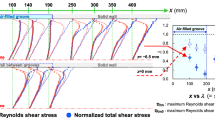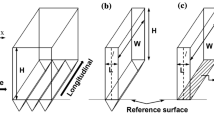Abstract
Slippery hydrodynamics in grooved hydrophobic microchannels is known to be primarily dictated by the area of the gas–liquid contact surface. Here, we augment this classical notion by bringing out the critical role played by the channel dimensions on the underlying slip mechanisms and the consequent drag reduction. Our analysis, towards this, reveals the non-trivial implication of gas–liquid interface topology and its position inside the groove towards dictating the underlying frictional characteristics, which in turn is largely dependent on the confluence of the channel hydraulic diameter and the groove width. These results may turn out to be of immense consequence towards arriving at preferred frictional drag characteristics of hydrophobic microchannels and nanochannels by judicious choices of the pertinent geometric parameters.








Similar content being viewed by others
References
Afkhami S, Bussmann M (2008) Height functions for applying contact angles to 2D VOF simulations. Int J Numer Methods Fluids 57:453–472
Brackbill JU, Kothe DB, Zemach C (1992) A continuum method for modeling surface tension. J Comput Phys 100:335–354
Chakraborty S (2007) Towards a generalized representation of surface effects on pressure-driven liquid flow in microchannels. Appl Phys Lett 90:034108
Chakraborty D, Dingari NN, Chakraborty S (2012) Combined effects of surface roughness and wetting characteristics on the moving contact line in microchannel flows. Langmuir 28:16701–16710
Chakraborty S, Chatterjee D, Bakli C (2013) Nonlinear amplification in electrokinetic pumping in nanochannels in the presence of hydrophobic interactions. Phys Rev Lett 110:184503
Chen H, Li L, Zhang T, Qiao Z, Tang J, Zhou J (2018) Protein translocation through a MoS2 nanopore: a molecular dynamics study. J Phys Chem C 122:2070–2080
Cheng Y, Teo C, Khoo B (2009) Microchannel flows with superhydrophobic surfaces: effects of Reynolds number and pattern width to channel height ratio. Phys Fluids 21:122004
Cheng Y, Xu J, Sui Y (2015) Numerical study on drag reduction and heat transfer enhancement in microchannels with superhydrophobic surfaces for electronic cooling. Appl Therm Eng 88:71–81
Choi C-H, Kim C-J (2006) Large slip of aqueous liquid flow over a nanoengineered superhydrophobic surface. Phys Rev Lett 96:066001
Cummins SJ, Francois MM, Kothe DB (2005) Estimating curvature from volume fractions. Comput Struct 83:425–434
Das A, Bhaumik SK (2018) Fabrication of cylindrical superhydrophobic microchannels by replicating lotus leaf structures on internal walls. J Micromech Microeng 28:045011
Davies J, Maynes D, Webb B, Woolford B (2006) Laminar flow in a microchannel with superhydrophobic walls exhibiting transverse ribs. Phys Fluids 18:087110
Dey P, Saha SK, Chakraborty S (2018) Microgroove geometry dictates slippery hydrodynamics on superhydrophobic substrates. Phys Fluids 30:122007
Francois MM, Cummins SJ, Dendy ED, Kothe DB, Sicilian JM, Williams MW (2006) A balanced-force algorithm for continuous and sharp interfacial surface tension models within a volume tracking framework. J Comput Phys 213:141–173
Fürstner R, Barthlott W, Neinhuis C, Walzel P (2005) Wetting and self-cleaning properties of artificial superhydrophobic surfaces. Langmuir 21:956–961
Gaddam A, Agrawal A, Joshi SS, Thompson M (2015) Utilization of cavity vortex to delay the wetting transition in one-dimensional structured microchannels. Langmuir 31:13373–13384
Genzer J, Efimenko K (2006) Recent developments in superhydrophobic surfaces and their relevance to marine fouling: a review. Biofouling 22:339–360
Gogte S, Vorobieff P, Truesdell R, Mammoli A, van Swol F, Shah P, Brinker CJ (2005) Effective slip on textured superhydrophobic surfaces. Phys Fluids 17:051701
Greenshields CJ (2015) OpenFOAM: The Open Source CFD Toolbox, User Guide OpenFOAM Foundation Ltd
Hirt CW, Nichols BD (1981) Volume of fluid (VOF) method for the dynamics of free boundaries. J Comput Phys 39:201–225
Holt JK et al (2006) Fast mass transport through sub-2-nanometer carbon nanotubes. Science 312:1034–1037
Holzmann T (2016) Mathematics, numerics, derivations and OpenFOAM® Loeben. Holzmann CFD, Germany
Jung YC, Bhushan B (2009) Wetting behavior of water and oil droplets in three-phase interfaces for hydrophobicity/philicity and oleophobicity/philicity. Langmuir 25:14165–14173
Kim TJ, Hidrovo C (2012) Pressure and partial wetting effects on superhydrophobic friction reduction in microchannel flow. Phys Fluids 24:112003
Lauga E, Stone HA (2003) Effective slip in pressure-driven Stokes flow. J Fluid Mech 489:55–77
Lee C, Choi C-H (2008) Structured surfaces for a giant liquid slip. Phys Rev Lett 101:064501
Li C, Zhang S, Xue Q, Ye X (2016) Simulation of drag reduction in superhydrophobic microchannels based on parabolic gas–liquid interfaces. Phys Fluids 28:102004
Liu T, Kim C-J (2014) Turning a surface superrepellent even to completely wetting liquids. Science 346(6213):1096–1100
Malik M, Fan ESC, Bussmann M (2007) Adaptive VOF with curvature-based refinement. Int J Numer Meth Fluids 55:693–712
Maynes D, Jeffs K, Woolford B, Webb B (2007) Laminar flow in a microchannel with hydrophobic surface patterned microribs oriented parallel to the flow direction. Phys Fluids 19:093603
McHale G, Shirtcliffe N, Evans C, Newton M (2009) Terminal velocity and drag reduction measurements on superhydrophobic spheres. Appl Phys Lett 94:064104
Motamedi M, Chung C-Y, Rafeie M, Hjerrild N, Jiang F, Qu H, Taylor A, Taylor RA (2019) Experimental testing of hydrophobic microchannels, with and without nanofluids, for solar PV/T collectors. Energies 12:3036
Ng C-O, Wang C (2009) Stokes shear flow over a grating: implications for superhydrophobic slip. Phys Fluids 21:087105
Nosonovsky M, Bhushan B (2009) Superhydrophobic surfaces and emerging applications: non-adhesion, energy, green engineering. Curr Opin Colloid Interf Sci 14:270–280
Ou J, Rothstein JP (2005) Direct velocity measurements of the flow past drag-reducing ultrahydrophobic surfaces. Phys Fluids 17:103606
Ou J, Perot B, Rothstein JP (2004) Laminar drag reduction in microchannels using ultrahydrophobic surfaces. Phys Fluids 16:4635–4643
Rusche H (2003) Computational fluid dynamics of dispersed two-phase flows at high phase fractions. Imperial College London (University of London)
Samaha MA, Vahedi Tafreshi H, Gad-el-Hak M (2011) Modeling drag reduction and meniscus stability of superhydrophobic surfaces comprised of random roughness. Phys Fluids 23:012001
Schäffel D, Koynov K, Vollmer D, Butt H-J, Schönecker C (2016) Local flow field and slip length of superhydrophobic surfaces. Phys Rev Lett 116:134501
Song D, Song B, Hu H, Du X, Du P, Choi C-H, Rothstein JP (2018) Effect of a surface tension gradient on the slip flow along a superhydrophobic air-water interface. Phys Rev Fluids 3:033303
Sussman M (2003) A second order coupled level set and volume-of-fluid method for computing growth and collapse of vapor bubbles. J Comput Phys 187:110–136
Teo CJ, Khoo BC (2010) Flow past superhydrophobic surfaces containing longitudinal grooves: effects of interface curvature. Microfluid Nanofluid 9:499–511
Teo C, Khoo B (2014) Effects of interface curvature on Poiseuille flow through microchannels and microtubes containing superhydrophobic surfaces with transverse grooves and ribs. Microfluid Nanofluid 17:891–905
Tsai P, Peters AM, Pirat C, Wessling M, Lammertink RG, Lohse D (2009) Quantifying effective slip length over micropatterned hydrophobic surfaces. Phys Fluids 21:112002
Van Leer B (1977) Towards the ultimate conservative difference scheme III. Upstream-centered finite-difference schemes for ideal compressible flow. J Comput Phys 23:263–275
Van Leer B (1979) Towards the ultimate conservative difference scheme. V. A second-order sequel to Godunov’s method. J Comput Phys 32:101–136
Weller H (1993) The development of a new flame area combustion model using conditional averaging Thermo-fluids section report TF 9307
Weller HG (2008) A new approach to VOF-based interface capturing methods for incompressible and compressible flow OpenCFD Ltd, Report TR/HGW 4
Woolford B, Jeffs K, Maynes D, Webb B (2005) Laminar fully-developed flow in a microchannel with patterned ultrahydrophobic walls. In: ASME 2005 Summer Heat Transfer Conference collocated with the ASME 2005 Pacific Rim Technical Conference and Exhibition on Integration and Packaging of MEMS, NEMS, and Electronic Systems, 2005. American Society of Mechanical Engineers, pp 481–488
Zhao S, Xue J, Kang W (2013) Ion selection of charge-modified large nanopores in a graphene sheet. J Chem Phys 139:114702
Acknowledgements
SC acknowledges Department of Science and Technology, Government of India, for Sir J. C. Bose National Fellowship.
Author information
Authors and Affiliations
Corresponding author
Additional information
Publisher's Note
Springer Nature remains neutral with regard to jurisdictional claims in published maps and institutional affiliations.
Rights and permissions
About this article
Cite this article
Dey, P., Saha, S.K. & Chakraborty, S. Confluence of channel dimensions and groove width dictates slippery hydrodynamics in grooved hydrophobic confinements. Microfluid Nanofluid 24, 23 (2020). https://doi.org/10.1007/s10404-019-2297-8
Received:
Accepted:
Published:
DOI: https://doi.org/10.1007/s10404-019-2297-8




